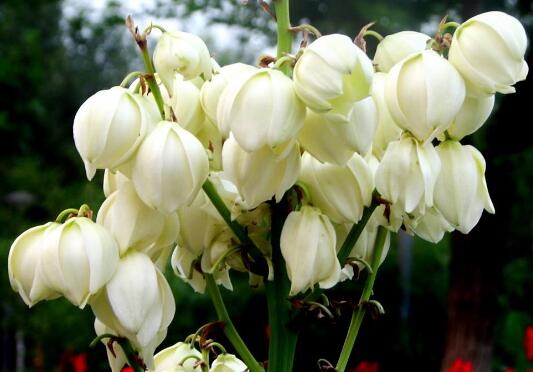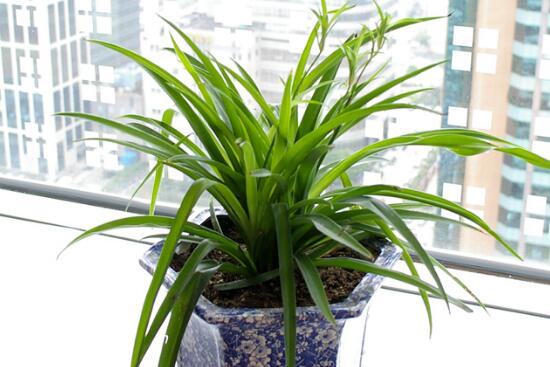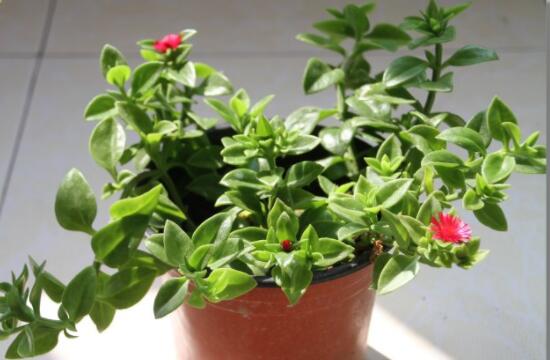How to raise potted phoenix orchid, phoenix orchid cultivation methods and precautions/avoid concentrated fertilizer
Onychoceria is an ornamental flower native to eastern and southeastern North America, and later introduced to China. Now it can be seen in many parts of China. However, if you want to raise it well, there are many places to pay attention to. How to raise potted hyacinth? What are the breeding methods and precautions of Phoenix tail orchid? The following small series takes everyone to understand.
1. How to raise potted phoenix orchids and understand habits

Want to know how to raise potted phoenix orchid, first of all we have to understand its growth habits, it prefers sunny environment, so we should keep it in sufficient light when breeding, in addition to the usual watering and fertilization is also need to pay attention to, the specific breeding method in the following, let's take a look at it.
II. Cultivation methods and precautions of Phoenix tail orchid
1. sandy soil
Before we cultivate Phoenix tail orchid, we should first choose soil, which is a step to lay a good foundation. Generally, it is best to choose loose and fertile sandy soil. This kind of soil has good drainage and permeability, which can make Phoenix tail orchid absorb nutrients better and is not easy to accumulate water.
2. Fertilization, 1-2 times per month during growth period
In the growth process of Ancyloidea, fertilizer is one of its main nutrients, especially after entering the growth period, its demand for nutrients is very high, basically need to fertilize 1-2 times a month, so that it can have enough nutrients to thrive. However, we must be careful to dilute the fertilizer with water before fertilizing. If the fertilizer is too thick, it is easy to burn the plants.
3. Water, frequent spraying in summer
This kind of plant is drought-tolerant, generally as long as it is not dry or wet, it can grow well, but after entering the summer, it still needs to be watered frequently, because the summer temperature is higher, the water will evaporate faster, so we had better spray water on the leaves every day, in order to maintain the humidity of the air, but also to make the leaves more tender green.
4. Light, avoid strong light
Phoenix orchid this kind of plant likes light more, but still need to master a degree when receiving light. If it is spring and autumn light is more suitable, we can let it receive light all day long. After entering summer, because the light is stronger, it still needs shade at noon.
5. Pest control should be timely
In the growth process of Phoenix tail orchid, if we do not care carefully enough, it is easy to appear diseases and insect pests. Such problems are extremely harmful to plants, which not only affect the ornamental property, but also lead to plant death when serious, so our prevention and control must be timely. For specific treatment methods, you can refer to the article on the prevention and control of diseases and insect pests in Phoenix tail orchid. Here, Xiaobian will not introduce too much.
The cultivation methods and precautions of Phoenix tail orchid, how to raise Phoenix tail orchid
Flower bonsai network guide, today's flower bonsai network Xiaobian to share with you the cultivation methods and precautions of the Phoenix orchid article, Phoenix orchid how to raise, there are flower friends who like to cultivate Phoenix orchid together to see it.
Phoenix tail orchid also known as pineapple flower or sisal, represents the hope of blooming, large clusters of flowers and towering posture make Phoenix tail flower become a kind of ornamental plant, so if we cultivate Phoenix tail flower by ourselves, what methods and precautions do we have?
The cultivation method of water hyacinth soil and fertilization
If potted, the soil commonly used is a mixture of rotting leaf soil and coarse sand. When the pot needs to be changed in spring, the old soil at the root of the plant needs to be removed, and then the dead roots and rotten roots are also cut off. When new leaves grow out, the old leaves also need to be cut off. Organic liquid fertilizer can be applied once or twice a month during plant growth.
watering
This kind of plant is more drought-tolerant, generally as long as it is not dry or wet, it can grow well, but it should be noted that it is necessary to irrigate enough water in summer, and it is best to spray water on the leaves every day, and to maintain a high air humidity, so that the color of the leaves will be more beautiful. After entering winter, the general hyacinth stopped growing, and at this time it was necessary to control water and fertilize.
growth environment
Phoenix is suitable for growing in warm, humid and sunny environments. It is drought-tolerant, cold-resistant and shade-tolerant. It has no strict requirements for soil and is very adaptable.
Potting soil is often mixed with moldy soil and coarse sand. When changing pots every spring, remove the old soil between the roots of the plants and cut off the withered and rotten roots. As the new leaves grow, cut off the yellow and withered old leaves at the lower part to keep the plant clean. During the growth period, organic liquid fertilizer is applied once or twice a month, and the plants are resistant to early growth and can grow well between dry and wet. Water enough in summer. Daily foliar spray to maintain high air humidity. The leaves are brighter. Stop growing in winter, control water and stop fertilizer.
Phoenix tail orchid likes warm and humid environment and plenty of sunshine, cold tolerance, shade tolerance, drought tolerance and humidity tolerance, the soil requirements are not strict. To fertile loose sandy loam is preferred. The barren and stony wasteland can also adapt. It has a wide range of adaptability to pH, and can grow except in saline-alkali soil.
Ancients like light, anti-pollution, strong germination, strong adaptability, stop growing at the top after flowering, lateral buds occur next to the leaf mark. Strong growth, strong fleshy roots, stems easy to produce adventitious buds, it is easy to grow buds, expand plants, renewal ability is very strong.
The reproductive mode of the hyacinth
Yucca can be propagated by sowing, rationing and cutting. The ramets of hyacinth can be planted separately in February and March in spring when the roots and buds are exposed to the ground. When subplanting, it is best to have some fleshy roots on each bud. First dig pits to fertilize, and then separate the tiller bud buried among them, buried soil not too deep, slightly cover the top can be. You can also cut off the part of the clustered leaves at the end of the stem, take a section of stem 9-12cm long, remove part of the leaves, leave about 7 leaves, bury them in a pit 12-15cm deep, and water them after burial. Because the leaves of hyacinth are densely grown and widely spread, the top is sharp, and the seedlings are bundled, and the bare roots can be used with soil. After many years of cultivation, young plants sprout from the roots. When the young plants grow up, they are cut off from the mother plants. Those with roots can be planted directly, and those without roots can be used as cuttings. Apply sulfur powder to the cuts, and then plant them in sterilized plain sand and place them in shade. Take root after about 50 days and move to a sunny place to cultivate. Cutting cuttage, in spring or early summer, dig stem, strip leaves, cut into 10 cm long, stem thick can be cut into 2-4 pieces, trenching flat, vertical section downward, cover 5 cm, maintain humidity, 20-30 days after insertion germination. Plant division, every spring, spring and autumn digging stem with leaves directly planted. Sowing hyacinth, seed reproduction can only be achieved through artificial pollination. Artificial pollination is best in May, seeds mature about 70 days after pollination, sown in late September of the same year, emergence rate is about 40% after one month. Seeds can also be stored until spring sowing. Cuttings are easy to survive. In spring or early summer, take the stem to remove the leaves, saw off according to each section of 10 cm, cut the thick ones into 2 or 4 pieces longitudinally, ditch flat, vertical section downward, cover the soil 5--10 cm thick, pay attention to the soil not to be too wet after insertion to prevent the stem from rotting. It is better to take fleshy root as cutting material. Phoenix tail orchid in the lower reaches of the Yellow River and its south areas, can be open winter. Because the leaves of Phoenix tail orchid are densely grown and widely spread, the top is sharp, so it should be tied first when digging, bare roots or soil can be used. Apply sufficient base fertilizer before planting, irrigate thoroughly after planting, remove binding materials and release leaves. Conservation management is very simple, just trim dead branches and leaves, and cut off flower stalks in time after flowering. After growing for many years, the stem is too high or inclined to the ground, and can be cut off and renewed. Dig a circular trench around the plant in the fall and apply some organic fertilizer.
Notes on the cultivation of water hyacinth
Newly cultivated hyacinths can survive as long as they are watered several times. Water according to soil conditions. Daily management should pay attention to proper soil cultivation and fertilization to promote the extraction of inflorescences; dead leaves and residual stems should be pruned in time to keep them clean and beautiful.
Yucca is not demanding about the type and amount of fertilizer. When potted, nitrogen, phosphorus and potassium compound fertilizer can be applied once or twice in spring and autumn, and no fertilizer is applied in winter and summer.
Disease and its control
Common diseases and insect pests of Ancyloidea are leaf spot disease and leaf spot disease. If you suffer from the last two diseases, you can spray 1000 times of 0% thiophanate-methyl WP.
Pests and their control
Common insect pests of hyacinth include scale insects, whiteflies and moths. If infected with the above pests, 40% omethoate emulsifiable concentrate can be sprayed with 1000 times solution.
Anthracnose is a frequent disease of hyacinth, spreading very fast, such as prevention and control is not timely after the onset, not only affect the viewing effect, severe cases will also lead to plant death. The symptoms, rules and control methods are introduced as follows: the symptoms first occur at the tip of the leaf, brown spots at the initial stage, then round or irregular outward expansion, gray brown spots, yellow halo around, scattered black particles on the surface, the whole leaf is black after infection.
The disease was infected by Colletotrichum agave, and the peak period was from mid-May to early October. The fungus overwinters on diseased leaves in hyphae, conidia and sclerotia state and spreads by wind and rain. High temperature, high humidity and tight ventilation conditions easy to come on. Control methods 1. Strengthen water and fertilizer management, enhance tree vigor and improve disease resistance of plants;2. Pay attention to selecting planting environment at the initial stage of planting, and have good ventilation environment in cultivation land;3. Remove diseased leaves in time and burn them intensively to reduce infection sources;4. Spray 50% Anthracnose Formex 300 times solution or 75% Chlorothalonil WP 1000 times solution once a week for 3~4 times continuously, which can effectively control the disease.
The above is the cultivation method and precautions of the Phoenix tail orchid, carefully cultivated, then there will be harvest!
The aquiculture method of phycloceria and attention phycloceria love yang, bear shade, can be put in the foyer that scatters sufficient light to watch. The leaves are green all the year round, several plants form clusters, different heights, sword-shaped leaves are arranged neatly, which can be planted in the center of flower beds, beside rocks or platform slopes, and near new buildings. It can also be used as a fence, or planted under walls and sheds. Ancyloidea has strong resistance to harmful gases and can be used as beautification and greening materials in mines.
Phoenix tail orchid also known as pineapple flowers, phoenix tail yucca, wind tail orchid tree beautiful green leaves, is a good garden ornamental trees. Because the leaves of Phoenix tail orchid are densely grown and widely spread, the tip is sharp, so it is bound first when digging, bare roots or soil can be used. Apply sufficient base fertilizer before planting, irrigate thoroughly after planting, remove binding materials and release leaves. Conservation and management is very simple, just trim dead branches and leaves, and cut off flower stalks in time after flowering. So, how should the phoenix tail orchid be raised? Below we will learn about the cultivation methods and precautions of the lower hyacinth.
The cultivation method of phoenix tail orchid:
Potting soil is often mixed with moldy soil and coarse sand. When changing pots every spring, remove the old soil between the roots of the plants and cut off the withered and rotten roots. As new leaves grow, cut off the yellow and withered old leaves at the lower part to keep the plant clean. During the growth period, organic liquid fertilizer is applied once or twice a month, and the plants are resistant to early growth and can grow well between dry and wet. Water enough in summer. Daily foliar spray to maintain high air humidity. The leaves are brighter. Stop growing in winter, control water and stop fertilizer.
Phoenix tail orchid likes warm and humid environment and plenty of sunshine, cold tolerance, shade tolerance, drought tolerance and humidity tolerance, the soil requirements are not strict. To fertile loose sandy loam is preferred. The barren and stony wasteland can also adapt. It has a wide range of adaptability to pH, and can grow except in saline-alkali soil.
Ancyprid like light, anti-pollution, strong germination, adaptability, after flowering, the top stop growing, next to the leaf mark from the occurrence of lateral buds. Strong growth, strong fleshy roots, stems easy to produce adventitious buds, it is easy to grow buds, expand plants, renewal ability is very strong.
Notes:
Newly cultivated hyacinths can survive as long as they are watered several times. Water according to soil conditions. Daily management should pay attention to proper soil cultivation and fertilization to promote the extraction of inflorescences; dead leaves and residual stems should be pruned in time to keep them clean and beautiful.
Yucca is not demanding about the type and amount of fertilizer. When potted, nitrogen, phosphorus and potassium compound fertilizer can be applied once or twice in spring and autumn, and no fertilizer is applied in winter and summer.
Cymbidium hyacinthii often occurs spot disease and leaf spot disease damage, available 70% thiophanate-methyl WP 1000 times spray. Insect pests are scale insects, whiteflies and moths harm, available 40% omethoate EC 1000 times spray kill.
- Prev

Why don't green-leaf orchids grow stems and leaves? more nitrogen, less potassium, less light is the key.
Although it is a beautiful foliage plant, we know that it is not difficult for Cymbidium to blossom under the condition of proper maintenance. However, in the process of breeding, many flower friends will encounter the situation that the green leaf orchid does not grow stems and leaves, which will eventually cause the plant not to blossom! So, why don't green leaf orchids grow stems and leaves?
- Next

How to raise peony spider orchid, peony spider orchid cultivation methods and precautions/summer shade
Peony, spider orchid, we certainly are not unfamiliar, they are very beautiful plants, that peony spider orchid we have seen it? It is understood that peony spider orchid leaves green, rose red flowers bloom at the top of the branches, with excellent ornamental. In life, many people want to raise peony spider orchid, then peony spider orchid how
Related
- Fuxing push coffee new agricultural production and marketing class: lack of small-scale processing plants
- Jujube rice field leisure farm deep ploughing Yilan for five years to create a space for organic food and play
- Nongyu Farm-A trial of organic papaya for brave women with advanced technology
- Four points for attention in the prevention and control of diseases and insect pests of edible fungi
- How to add nutrient solution to Edible Fungi
- Is there any good way to control edible fungus mites?
- Open Inoculation Technology of Edible Fungi
- Is there any clever way to use fertilizer for edible fungus in winter?
- What agents are used to kill the pathogens of edible fungi in the mushroom shed?
- Rapid drying of Edible Fungi

